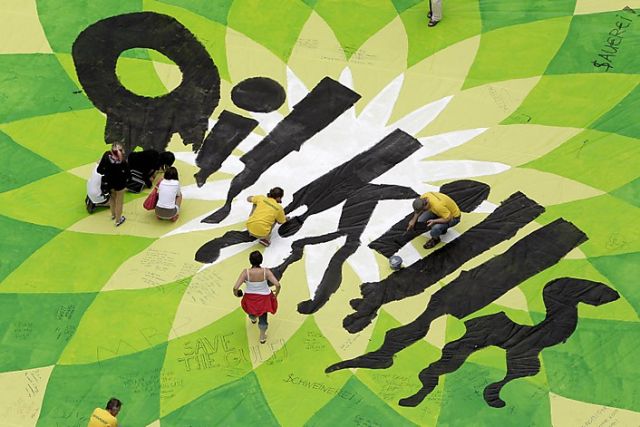
The Gulf of Mexico is still threatened with an ecological catastrophe, but the US government and British Petroleum (BP) are trying to cover up the scale of BP’s Macondo oil well disaster.
About 4.9 million barrels of oil escaped into the sea after the Deepwater Horizon rig exploded on April 20, killing 11 workers. BP capped the well on July 15, but work on the relief well to permanently plug the spill is expected to be delayed until early September, Bloomberg.com said on August 20.
On August 4, BP and the US government claimed that 75% of the oil was “gone” — either captured, burned off, evaporated or broken down — and that no new oil should be found. US President Barack Obama even swam in gulf waters with his family to “prove” the safety of the area, ABC Online said on August 15.
Scientists from the University of Georgia disputed the alleged disappearance, releasing their own analysis showing up to 79% of the oil that spilled into the Gulf of Mexico remained in the water, the Guardian said on August 18.
Bill Lehr, a senior scientist at the National Oceanographic and Atmospheric Administration (NOAA), the government body that made the original claim, was forced to admit to the US House Energy and Commerce Committee that “most of that [oil] is still in the environment,” the Guardian said on August 19.
A number of scientists have accused NOAA of discouraging them from making public their findings about lingering oil in the deepwater.
Experts from Woods Hole Oceanographic Institution in Massachusetts said they have also found a long-lasting 35 km "mist" of oil, the British Daily Telegraph said on August 20.
An August 17 report at DailyBeast.com exposed the fact that fishing boat operators hired by BP to help with the clean-up are still finding tar balls and oil slicks, but are ordered to hide their discoveries.
Mark Williams, one such a fishing boat captain, wrote in his logbook that he was told by a supervisor: “no reporting of oil or tar balls anymore. Don't put on report. We're here for [oil containment] boom removal only.”
Also under question is the wide-scale use of Corexit, an oil dispersant produced by BP. The effects of Corexit on marine life have not been fully studied.
Some have questioned the logic of using a dispersant, which spreads the oil and undermines containment efforts. Dispersant use has one obvious effect that is beneficial for the vested interests involved — it sends the oil below the surface and out of sight, tactics in line with BP's ongoing emphasis on putting media spin ahead of environmental protection.
Even more concerning is Corexit's potential effects on the environment. Some research has suggested that Corexit made organisms more vulnerable to the toxic components in the oil, the August 18 Guardian said. The paper said it makes the oil particles smaller and more easily absorbed by animals at all levels of the food chain.
Rick Steiner, a conservation specialist from the University of Alaska told the September/October issue of Mother Jones: "Oil is toxic to most life. And Corexit is toxic to most life. But the most toxic of all is oil that's been treated with Corexit. Plus, dispersants may well kill the ocean's first line of defence against oil: the natural microbes that break oil down for other microbes to eat."
The vast amount of oil in the Gulf is also likely to significantly disrupt the food chain in a number of ways, threatening to permanently alter this fragile ecosystem.
Mother Jones described how underwater oil plumes have disrupted marine life, not only by lethal exposure to oil, but also by blocking the usual movements of fish, keeping them from their food supply and starving their predators.
As previous spills have shown, animals not directly killed by the oil will have ongoing health problems that will likely last for generations.
Dispersed oil also appears to be having a toxic effect on bacteria and phytoplankton, Xinhuanet.com said on August 20.
In the meantime, the people of the Gulf of Mexico area face yet another threat from the spill.
The August 16 Washington Post said the clean-up effort has already created more than 45,000 tons of garbage, which is being dumped in landfills near residential areas.
The US Environmental Protection Agency said the waste is “not hazardous”, but locals remain extremely sceptical, given that clean-up workers are required to wear protective clothing when handling the waste.
Marlin Ladner, a member of the Board of Supervisors in Harrison County told the Washington Post: "It's like somebody dumping waste in your front yard, then putting it in your back yard."
Robert Bullard, director of the Environmental Justice Resource Center at Clark Atlanta University said 61% of the waste from the oil spill has been sent to landfills in minority and low-income communities, while some richer, whiter communities had been spared.
Victims of the spill are also facing a tough choice after it was revealed that anyone who accepts financial settlements from BP's US$20 billion compensation fund will be prohibited from taking further legal action for compensation, the British Daily Telegraph said.
Many people who are desperately short of money may have to accept payouts below what they may otherwise receive under a court settlement.